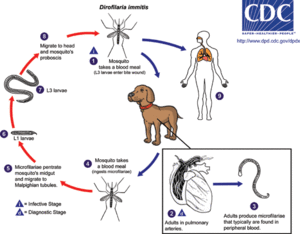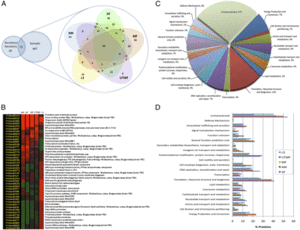Dirofilaria immitis: Difference between revisions
Jessieholt (talk | contribs) No edit summary |
Jessieholt (talk | contribs) No edit summary |
||
| Line 9: | Line 9: | ||
==Characteristics of the host== | ==Characteristics of the host== | ||
The host involved in this interaction with ''Wolbachia'' is the parasitic roundworm ''Dirofilaria immitis''. The main host that ''D. immitis'' infects is the canine, but it has also been found in felines as well as other animals | The host involved in this interaction with ''Wolbachia'' is the parasitic roundworm ''Dirofilaria immitis''. The main host that ''D. immitis'' infects is the canine, but it has also been found in felines as well as other animals. ''D. immitis'' produces the vector borne disease Dirofilariasis that is transmitted through the mosquito intermediate host. This occurs through a series of stages. The mosquito firstly acquires microfilariae through feeding on an infected host. Within the mosquito, the larva then develops through several stages of molting. When the mosquito feeds again, the larvae enter the new host through the feeding site. Larvae become sexually mature adults over the course of approximately two to three months, and if both male and female ''D. immitis'' are present in the host, they will mate and microfilariae will be released into the new host upon feeding. [7] This transmission can be dependent on and affected by various factors. Mosquito vectors need to be available, a canine population has to be available, and the appropriate temperature needs to be maintained. For microfilarae to develop into the L3 and infective stage the temperature should be in the range of 18C° to 34°C [16]. Figure 1 shows the life cycle of ''Dirofilaria immitis'', beginning with the common mosquito infection and ending with the development of infectious larvae [7]. | ||
[[File:dimmitis.gif|thumb|"Life Cycle of ''Dirofilaria immitis'''' [http://www.dpd.cdc.gov/dpdx/HTML/ImageLibrary/Filariasis_il.htm]]] | [[File:dimmitis.gif|thumb|"Life Cycle of ''Dirofilaria immitis'''' [http://www.dpd.cdc.gov/dpdx/HTML/ImageLibrary/Filariasis_il.htm]]] | ||
Revision as of 15:19, 5 December 2011
WIKI IN PROGRESS
Ex. [[]]
Characteristics of the symbiont/pathogen
Wolbachia are of the diverse order Rickettsiales which encompasses intracellular bacteria that have commensal, mutualistic, and parasitic host relationships. Wolbachia are gram negative bacterial symbionts that take the forms of small rods and coccids and are 0.5 to 1.3 μm in size. Wolbachia is the most plentiful intracellular bacteria found to date with 65% of insect species containing this microbe. There are only two fully sequenced Wolbachia genomes available, but partial genomes have been assembled through invertebrate sequencing projects. The Wolbachia genome is small at around 1.08-1.7 Mb. There is not a fully sequenced Wolbachia genome with the Dirofilaria immitis host. However, the Wolbachia genomes that have been sequenced have a high number of replicates and repetitive factors. A large number of these repeats are ankyrin domains that are uncommon in bacteria. However, these domains influence the protein interactions of the host and pathogen. [1]
Characteristics of the host
The host involved in this interaction with Wolbachia is the parasitic roundworm Dirofilaria immitis. The main host that D. immitis infects is the canine, but it has also been found in felines as well as other animals. D. immitis produces the vector borne disease Dirofilariasis that is transmitted through the mosquito intermediate host. This occurs through a series of stages. The mosquito firstly acquires microfilariae through feeding on an infected host. Within the mosquito, the larva then develops through several stages of molting. When the mosquito feeds again, the larvae enter the new host through the feeding site. Larvae become sexually mature adults over the course of approximately two to three months, and if both male and female D. immitis are present in the host, they will mate and microfilariae will be released into the new host upon feeding. [7] This transmission can be dependent on and affected by various factors. Mosquito vectors need to be available, a canine population has to be available, and the appropriate temperature needs to be maintained. For microfilarae to develop into the L3 and infective stage the temperature should be in the range of 18C° to 34°C [16]. Figure 1 shows the life cycle of Dirofilaria immitis, beginning with the common mosquito infection and ending with the development of infectious larvae [7].

Host-Symbiont Interaction
What kind of interaction do host and symbiont have? How is the host affected by the relationship? How does the host acquire and transmit the symbiont? Is the interaction obligate or facultative?
Molecular Insights into the Symbiosis
Describe molecular/genetic studies on the symbiosis.

Ecological and Evolutionary Aspects
What is the evolutionary history of the interaction? Do particular environmental factors play a role in regulating the symbiosis?
Recent Discoveries
Describe two findings on the symbiosis published within the last two years.
References
[1] Werren, John H., Laura Baldo, and Michael E. Clark. "Wolbachia: Master Manipulators of Invertebrate Biology." Nature Reviews Microbiology 6.10 (2008): 741-51
Edited by Jessie Holt, student of Grace Lim-Fong
